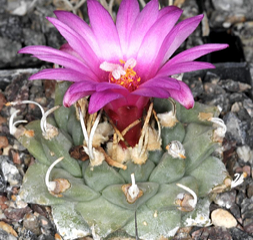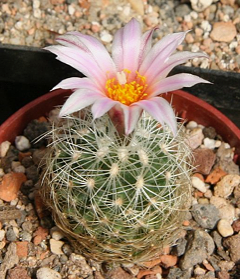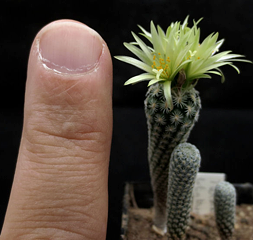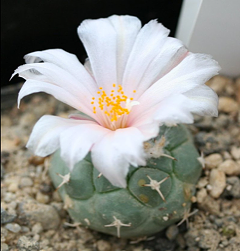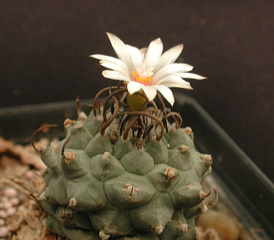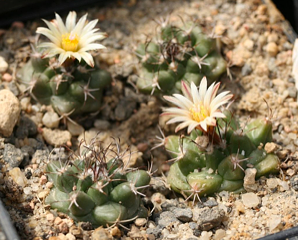Submitted by: Jim Tanner
Turbinicarpus is a small (but growing) genus of small plants from Northeastern and Central Mexico. It is one of several closely related genera, Neolloydia, and Gymnocactus, and Strombocactus being the ones most frequently mentioned. In many books, some of the plants listed below will appear as either Neolloydia or Gymnocactus. The exact relation of these genera is still being worked out and the disagreements between botanists are substantial. New species have been discovered and named in the past decade; seeds and plants of these are just becoming available.
All of the Turbinicarpus species are worth growing. They are all small, most full sized in collections at an inch or two. A few will clump readily, and make impressive show specimens, as shown below, but still remain manageable. A collection of all the species and varieties could easily fit on a table top.
In habitat, Turbinicarpus usually grow under nurse plants, generally shrubs that offer some protection from the worst of the mid day sun. Turbinicarpus have large tuberous roots, which are their primary food and water storage source in times of drought. Over much of their habitat, rain falls during the summer, and growth is most rapid during this period. They can take lots of heat.
Turbinicarpus are fairly easy to grow, if attention is paid to their life cycle. They are dormant in winter, from November through mid March. As they begin growth, watering has to start slowly. If too much water and fertilizer is given at once, it’s possible to burst the skin of the plant. Once growth is going (April and after) water freely. During very hot weather in the summer, the plants sometimes go dormant again for a short period. Attention has to be paid to watering again.
If a head splits, all is not lost. The entire head can be removed, and the top of the tuberous root left half an inch above the soil. It will usually start two or three new heads. Removing a head is also a great way for vegetative propagation. Turbinicarpus can be raised from seed. They are slow for the first year, but reasonable size plants can be grown in a year or two, and flowers the size of the plant will appear by the second year. Producing clumps as shown above will take quite a bit longer.
Tom Glavich
LATIN LOOKUP – Loquerisne Latine (Do you speak Latin)?
The meanings of latin plant names on this page – from http://davesgarden.com/guides/botanary/
- alonsoi [al-ON-so-eye]
Named for Alonso Garcia Luna, who discovered the plant as a young boy accompanying Charles Glass in Mexico. - lophophoroides [lof-oh-for-OY-deez]
Resembles Lophora (genus name, from the Greek lophos, crest; and phoreo, bearer, carrier). - Turbinicarpus [tur-bin-ih-KAR-pus]
From the Latin turbino (spinning) and karpos (fruit).
